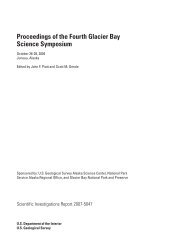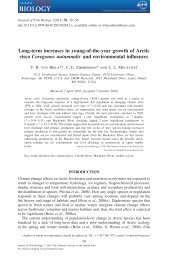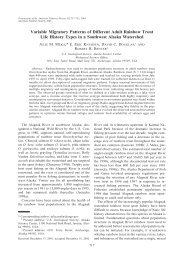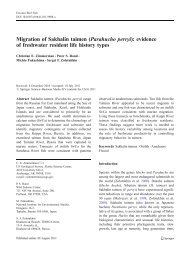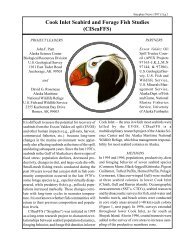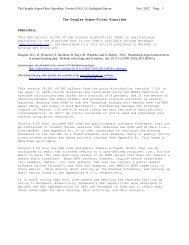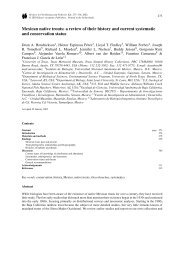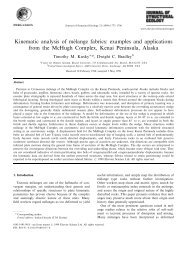Kline, T. C., C. A. Woody, M. A. Bishop, S. P. Powers, and E. E. ...
Kline, T. C., C. A. Woody, M. A. Bishop, S. P. Powers, and E. E. ...
Kline, T. C., C. A. Woody, M. A. Bishop, S. P. Powers, and E. E. ...
Create successful ePaper yourself
Turn your PDF publications into a flip-book with our unique Google optimized e-Paper software.
American Fisheries Society Symposium 54:51–60, 2007<br />
© 2007 by the American Fisheries Society<br />
Assessment of Marine-Derived Nutrients in the Copper<br />
River Delta, Alaska, Using Natural Abundance of the<br />
Stable Isotopes of Nitrogen, Sulfur, <strong>and</strong> Carbon<br />
Thomas C. <strong>Kline</strong>, Jr., Carol Ann <strong>Woody</strong>, Mary Anne <strong>Bishop</strong>, Sean P. <strong>Powers</strong>, <strong>and</strong> E. Eric Knudsen<br />
ABSTRACT We performed nitrogen, sulfur, <strong>and</strong> carbon stable isotope analysis (SIA) on maturing <strong>and</strong> juvenile<br />
anadromous sockeye <strong>and</strong> coho salmon, <strong>and</strong> periphyton in two Copper River delta watersheds of Alaska to trace salmonderived<br />
nutrients during 2003–2004. Maturing salmon were isotopically enriched relative to alternate freshwater N, S,<br />
<strong>and</strong> C sources as expected, with differences consistent with species trophic level differences, <strong>and</strong> minor system, sex,<br />
<strong>and</strong> year-to-year differences, enabling use of SIA to trace these salmon-derived nutrients. Periphyton naturally colonized,<br />
incubated, <strong>and</strong> collected using Wildco Periphtyon Samplers in <strong>and</strong> near spawning sites was 34 S- <strong>and</strong> 15 N-enriched, as<br />
expected, <strong>and</strong> at all freshwater sites was 13 C-depleted. At nonspawning <strong>and</strong> coho-only sites, periphyton 34 S <strong>and</strong> 15 N was<br />
generally low. However, 34 S was low enough at some sites to be suggestive of sulfate reduction, complicating the use of<br />
S isotopes. Juvenile salmon SIA ranged in values consistent with using production derived from re-mineralization as well<br />
as direct utilization, but only by a minority fraction of coho salmon. Dependency on salmon-derived nutrients ranged from<br />
relatively high to relatively low, suggesting a space-limited system. No one particular isotope was found to be superior<br />
for determining the relative importance of salmon-derived nutrients.<br />
Perhaps the most far-reaching l<strong>and</strong>-sea<br />
animal-mediated ecological connection,<br />
in terms of distance, is the role that<br />
semelparous <strong>and</strong> anadromous Pacific salmon<br />
play in transporting nutrients. When maturing<br />
salmon return to their natal habitat, they<br />
deliver nutrients acquired in marine environments<br />
into freshwaters <strong>and</strong> coastal areas<br />
where they migrate, spawn, <strong>and</strong> die. In certain<br />
years in some systems (e.g., Kvichak<br />
River system, western Alaska) or annually in<br />
other systems (Karluk River system, Kodiak<br />
Isl<strong>and</strong>), salmon may provide the major source<br />
of N <strong>and</strong> by extension other essential nutrients<br />
(reviewed by <strong>Kline</strong> et al. 1997).<br />
The N, S, C, <strong>and</strong> other nutrients delivered<br />
by anadromous salmon are collectively<br />
referred to as marine-derived nutrients<br />
(abbreviated here as mdn) or individually as<br />
marine-derived N, S, <strong>and</strong> C, which are abbreviated<br />
here as, respectively, MDN, MDS, <strong>and</strong><br />
MDC. Adult salmon consist almost entirely of<br />
matter acquired during their marine life history<br />
phase. Because freshwater <strong>and</strong> marine<br />
habitats are geographically separated, elemental<br />
pools comprising them have disparate<br />
histories leading to distinct stable isotope signatures<br />
that can be exploited as tracers of<br />
THOMAS C. KLINE, JR. Prince William Sound Science Center,<br />
Cordova, Alaska 99574, USA. Corresponding author: tkline@pwssc.<br />
gen.ak.us<br />
CAROL ANN WOODY USGS, Alaska Science Center, Anchorage,<br />
Alaska 99508, USA<br />
MARY ANNE BISHOP Prince William Sound Science Center, Cordova,<br />
Alaska 99574, USA<br />
SEAN P. POWERS University of South Alabama & Dauphin Isl<strong>and</strong> Sea<br />
Laboratory, Dauphin Isl<strong>and</strong>, Alabama 36528, USA<br />
E. ERIC KNUDSEN Mount Vernon, Washington 98273, USA<br />
51
KLINE ET AL.<br />
these sources when brought together by<br />
salmon migration.<br />
Nitrogen delivered by returning anadromous<br />
salmon was found to be relatively 15N<br />
enriched compared to alternate N sources<br />
(reviewed by <strong>Kline</strong> et al. 1997). Terrestrial<br />
<strong>and</strong> freshwater ecosystems generally depend,<br />
directly or indirectly, on N fixation from air<br />
N 2 . Nitrogen fixation generates plant material<br />
having a stable N isotope composition<br />
approximately that of air, low in 15N content,<br />
with a δ15N value of 0 0 / 00; by definition.<br />
Marine nitrate <strong>and</strong> ammonium are 15Nenriched<br />
relative to N in air, resulting in 15Nenriched<br />
food web constituents. The relative<br />
increase of 15N that occurs with each feeding<br />
step further elevates 15N levels such that<br />
salmon deliver to terrestrial <strong>and</strong> freshwater<br />
ecosystems N that is more than 1% 15N<br />
enriched relative to air (<strong>Kline</strong> 1991). 15N has<br />
also been shown to be an effective tracer of<br />
MDN in estuarine food webs (Fujiwara <strong>and</strong><br />
Highsmith 1997).<br />
Unlike nitrogen nutrient dynamics, the<br />
sulfur cycle in salmon ecosystems is poorly<br />
described. Sulfate is an important chemical<br />
constituent to the salinity of seawater comprising<br />
the second most common anion, <strong>and</strong> has a<br />
consistent δ34S value of +21 0 / 00 (Michener <strong>and</strong><br />
Schell 1994). Furthermore, δ34S values are<br />
conserved across food web trophic levels (Fry<br />
1988). The δ34S values of marine organisms<br />
are thus generally confined to a narrow range.<br />
For example, δ34S values of organisms from<br />
the Georges Bank ranged from +16–18 0 / 00 (Fry<br />
1988). Freshwater sulfate is relatively 34Sdepleted<br />
with inputs largely due to precipitation<br />
with values ranging from +2–8 0 / 00 (Michener<br />
<strong>and</strong> Schell 1994). For example, the δ34S<br />
values measured in stream water in the Hubbard<br />
Brook Experimental Forest, New Hampshire<br />
ranged from +3.2–4.9 0 / 00 for the<br />
1963–1993 period (Alewell et al. 1999). Sulfur,<br />
however, is significantly 34S-depleted<br />
when reduced to sulfide, so that δ34S values<br />
are reduced about 30–40 0 / 00 relative to sulfate<br />
(Michener <strong>and</strong> Schell 1994). Therefore the<br />
expected δ34S range was from ~ –35 to +5 0 / 00<br />
according to the importance of sulfate reduction<br />
in the system.<br />
Salmon carbon has been found to be generally<br />
13C-enriched relative to freshwater carbon<br />
sources (<strong>Kline</strong> et al. 1990). However, the<br />
δ13C values of primary producers in freshwater<br />
systems may range from very low values<br />
when they take up carbon released from<br />
decomposition to relatively high values in littoral<br />
zones assumed to be due to changing<br />
fractionation effects from depletion of dissolved<br />
inorganic carbon (<strong>Kline</strong> et al. 1993).<br />
Thus δ13C may be a better qualitative than<br />
quantitative indicator of MDC except for<br />
when salmon are consumed directly.<br />
Remineralization (RP) versus Direct<br />
Consumption (DP) Pathways<br />
Stable isotope analysis (SIA) methods can<br />
delineate mdn pathways from salmon to<br />
freshwater biota (<strong>Kline</strong> et al. 1993). The direct<br />
pathway (DP) is whereby salmon components<br />
(organic marine-derived nutrients) are utilized<br />
directly such as when salmon eggs <strong>and</strong><br />
carcasses are fed upon by consumers. Marine<br />
organic mdn is by definition an allochthonous<br />
N, S, <strong>and</strong> C source. The re-mineralization<br />
pathway (RP) is indirect—salmon nutrients<br />
return to an inorganic state (inorganic marinederived<br />
nutrients) <strong>and</strong> therefore must be<br />
taken up by primary producers to re-enter the<br />
food chain. Marine N, S, <strong>and</strong> C are decoupled<br />
during decomposition. For example, primary<br />
producers taking up inorganic marine N<br />
through the RP could have C <strong>and</strong> S isotope<br />
compositions that are different from that of<br />
returning salmon. N, S, <strong>and</strong> C derived from<br />
RP is autochthonous production. The RP can<br />
result from nutrient releases taking place prior<br />
to decomposition of the carcasses. For example,<br />
approximately 30% of the N delivered by<br />
52
ASSESSMENT OF MARINE-DERIVED NUTRIENTS IN THE COPPER RIVER DELTA<br />
salmon may be released prior to decomposition<br />
as excrement <strong>and</strong> gametes (Mathisen et<br />
al. 1988). The RP has been shown to be<br />
important for pelagic systems such as sockeye<br />
salmon nursery lakes (<strong>Kline</strong> et al. 1993) while<br />
the DP may be more important in stream systems<br />
(Bilby et al. 1996). The RP <strong>and</strong> DP generated<br />
different expected stable isotope values<br />
in biota because, whereas C <strong>and</strong> N remain<br />
coupled when marine organic N was consumed,<br />
they were decoupled during decomposition<br />
(<strong>Kline</strong> et al. 1993). We expected a<br />
similar result for S. Because N is enriched by<br />
trophic process, the DP results in δ15N values<br />
of consumers greater than that of the marine<br />
source. Because S <strong>and</strong> C isotopes values are<br />
more conservative in food chains, the expected<br />
δ34S <strong>and</strong> δ13C’ values in a DP food<br />
web would be approximately the same as<br />
adult salmon. In all cases isotope values<br />
were expected to be positively correlated to<br />
MDN, MDS, <strong>and</strong> MDC, <strong>and</strong> therefore with<br />
each other.<br />
Marine-derived nutrients are hypothesized<br />
to be an integral component of biological<br />
productivity in salmon watersheds; this<br />
study was done to further establish where,<br />
when <strong>and</strong> how both marine- <strong>and</strong> watershedderived<br />
nutrients should be monitored using<br />
stable isotopes.<br />
Study Area<br />
SIA was used to trace mdn in the Copper<br />
River delta (CRD). The CRD is a coastal plain<br />
measuring ~50 km east–west by ~20 km<br />
north–south in size bounded by the Chugach<br />
Mountains to the north <strong>and</strong> the Gulf of Alaska<br />
to the south. Eyak Lake <strong>and</strong> the Heney<br />
Range, which are adjacent to Cordova, Alaska,<br />
form the western boundary, whereas Ragged<br />
Mountain, immediately east of the Copper<br />
River, forms the eastern boundary. The CRD<br />
watershed includes the Copper River, with a<br />
watershed that bounds the Alaska Range to<br />
the north, <strong>and</strong> numerous smaller rivers <strong>and</strong><br />
lakes draining from the Chugach Mountains<br />
including Eyak <strong>and</strong> McKinley Lakes. Sampling<br />
for SIA focused on two CRD systems,<br />
the McKinley-Alaganik system, which is<br />
located immediately west of the Copper River,<br />
<strong>and</strong> the Eyak system that forms the western<br />
portion of the CRD (Table 1). Annual precipitation<br />
in Eyak <strong>and</strong> McKinley Lakes is<br />
about 4.5 m <strong>and</strong> 3.5 m, <strong>and</strong> ice cover lasts<br />
3–7 <strong>and</strong> 5–7 months, respectively (corrected<br />
metric conversion from Pellissier <strong>and</strong> Somerville<br />
1987). Alaganik Slough drains the westernmost<br />
branch of the Copper River <strong>and</strong><br />
McKinley Lake (surface area = 114 ha, maximum<br />
depth = 11 m, mean depth = 5.1<br />
m; Pellissier <strong>and</strong> Somerville 1987). Power<br />
Creek, which is glacial, is the principal<br />
salmon spawning tributary of Eyak Lake (surface<br />
area = 1,000 ha, maximum depth = 7<br />
m, mean depth = 1.7 m; Pellissier <strong>and</strong><br />
Somerville 1987).<br />
Salmon species of interest are sockeye<br />
Oncorhynchus nerka <strong>and</strong> coho O. kisutch that<br />
spawn <strong>and</strong> rear in the CRD prior to smolting.<br />
Maturing sockeye salmon enter CRD freshwaters<br />
in late May <strong>and</strong> spawn from July to October,<br />
at which time coho salmon arrive <strong>and</strong><br />
spawn until December. A small number<br />
(~500) of pink salmon O. gorbuscha also<br />
spawn in the Eyak system compared to about<br />
10,000 sockeye <strong>and</strong> 7,500 coho salmon (Pellissier<br />
<strong>and</strong> Somerville 1987). Approximately<br />
7,000 sockeye <strong>and</strong> 1,500 coho salmon spawn<br />
within the McKinley watershed (Pellissier <strong>and</strong><br />
Somerville 1987). A small but unspecified<br />
number of coho salmon also spawn in Alaganik<br />
Slough. What may also be significant<br />
are occasional large (thous<strong>and</strong>s of individuals),<br />
but poorly documented, runs of anadromous<br />
<strong>and</strong> semelparous eulachon Thaleichthys<br />
pacificus that arrive <strong>and</strong> spawn in Alaganik<br />
Slough <strong>and</strong> Eyak River during late winter to<br />
early spring providing an additional marine<br />
nutrient source.<br />
53
KLINE ET AL.<br />
Table 1.<br />
Periphyton δ15N, δ13C, <strong>and</strong> δ34S data with MDN <strong>and</strong> MDS based on these values from the Copper River Delta in 2004.<br />
Deployment Recovery<br />
System Station Type WPS # date date δ13C δ15N MDN δ34S MDS<br />
Eyak<br />
Fresh<br />
Power Creek Gauging Station Coho P-002 22-Jun 21-Sep -28.5 -0.4 7% 6.0 28%<br />
Eyak Lake Mavis Isl<strong>and</strong> Lacustrine P-048 10-Aug 21-Sep -23.4 5.7 84% 5.3 24%<br />
Eyak Lake Davis Cove Turnaround Lacustrine P-050 10-Aug 21-Sep -29.7 3.9 61% 6.3 29%<br />
Mouth of Power Creek Riverine P-001 22-Jun 21-Sep -28.3 3.4 56% 3.3 14%<br />
Power Creek Spawning Channel Riverine P-029 22-Jun 21-Sep -30.1 6.2 90% 10.0 49%<br />
Eyak R. Boat Launch Riverine P-046 10-Aug 21-Sep -24.5 4.6 70% 11.5 57%<br />
Salt<br />
Low-intertidal #1 Estuarine P-007 23-Jun 16-Sep -18.7 5.6 82% 17.2 87%<br />
Low-intertidal #2 Estuarine P-006 23-Jun 16-Sep -17.9 4.1 63% 15.1 76%<br />
Low-intertidal #3 Estuarine P-008 23-Jun 16-Sep -18.0 5.7 84% 8.7 95%<br />
Mid-intertidal #1 Estuarine P-004 23-Jun 16-Sep -20.3 5.9 87% 18.3 93%<br />
Mid-intertidal #2 Estuarine P-005 23-Jun 16-Sep -17.8 5.8 85% 18.3 93%<br />
Mid-intertidal #3 Estuarine P-003 23-Jun 16-Sep -20.6 7.4 105% 17.1 86%<br />
High-intertidal #1 Estuarine P-014 23-Jun 16-Sep -20.3 5.1 76% 16.9 85%<br />
High-intertidal #2 Estuarine P-013 23-Jun 16-Sep -20.7 4.9 74% 17.6 89%<br />
High-intertidal #3 Estuarine P-012 23-Jun 16-Sep -20.9 4.7 71% 19.6 99%<br />
McKinley-Alaganik<br />
Fresh<br />
Salmon Creek Coho P-034 5-Aug 18-Sep -37.7 -0.2 10% -5.2 -31%<br />
Lucky Strike Control P-038 5-Aug 18-Sep -35.2 -1.0 0% 1.9 6%<br />
McKinley Lake Cabin Lacustrine P-036 5-Aug 18-Sep -28.7 5.2 77% 2.4 9%<br />
McKinley Lake Lost Point Lacustrine P-037 5-Aug 18-Sep -25.9 2.5 44%<br />
McKinley Lake Swamp Lacustrine P-042 10-Aug 18-Sep -32.6 4.1 64% 11.3 56%<br />
Alaganik Slough Boat Launch Riverine P-044 5-Aug 18-Sep -26.9 6.0 87% 3.8 16%<br />
Salt<br />
Pete Dahl Low-intertidal #2 Estuarine P-009 23-Jun 16-Sep -6.5 2.2 40% 16.2 82%<br />
Pete Dahl Low-intertidal #3 Estuarine P-010 23-Jun 16-Sep -13.3 3.1 51% 17.8 90%<br />
Pete Dahl Mid-intertidal #1 Estuarine P-019 23-Jun 16-Sep -8.5 1.8 35% 14.8 74%<br />
Pete Dahl Mid-intertidal #3 Estuarine P-018 23-Jun 16-Sep -12.8 3.1 52% 16.2 82%<br />
Pete Dahl High-intertidal #1 Estuarine P-017 23-Jun 16-Sep -15.7 3.8 60% 19.6 100%<br />
Pete Dahl High-intertidal #2 Estuarine P-015 23-Jun 16-Sep -11.0 2.7 46% 18.3 93%<br />
Pete Dahl High-intertidal #3 Estuarine P-016 23-Jun 16-Sep -12.4 3.7 58% 17.3 87%<br />
Methods<br />
Sampling Sites<br />
Sampling sites were selected in order to have<br />
a range of salmon impact, from little to no<br />
salmon impact to high spawning density in<br />
both watersheds, <strong>and</strong> by logistical constraints.<br />
Except for the inter-tidal sites, access was by<br />
vehicle <strong>and</strong> on foot using existing trails. Sampling<br />
sites were established on Mill <strong>and</strong><br />
Salmon Creeks, tributaries of McKinley Lake<br />
<strong>and</strong> on the shores of McKinley Lake. A<br />
salmon-free control site was established on<br />
Mill Creek near the ab<strong>and</strong>oned Lucky Strike<br />
silver <strong>and</strong> gold mine (less than 2 kg was<br />
mined). The Lucky Strike site was the highest<br />
elevation site in the system at ~58 m above sea<br />
level. The stream at the Lucky Strike site,<br />
which was clear, was about 1.5 m wide <strong>and</strong><br />
less than 10 cm deep. Salmon access was<br />
blocked downstream of the site by fallen trees<br />
<strong>and</strong> boulders. A sampling site was established<br />
near the McKinley Lake U.S. Forest Service<br />
cabin where spawning occurs on the shores of<br />
the lake near the mouth of Mill Creek. Another<br />
McKinley shore site, Lost Point, was estab-<br />
54
ASSESSMENT OF MARINE-DERIVED NUTRIENTS IN THE COPPER RIVER DELTA<br />
lished near the deepest part of the lake. The<br />
“swamp” site located between Lost Point <strong>and</strong><br />
the lake outlet is where the forest is inundated<br />
by the lake <strong>and</strong> where the water appears<br />
stained with dissolved organic material. The<br />
site on Salmon Creek, also a tributary of<br />
McKinley Lake, was near mile marker 21 on<br />
the Copper River Highway (the roadway<br />
crossing the CRD east–west).<br />
The uppermost site (elevation = 10 m<br />
above sea level) on Power Creek was that of<br />
the ab<strong>and</strong>oned USGS gauging station. A clear<br />
side-channel of Power Creek was selected as a<br />
high spawner density site (~1000 spawners<br />
combining all species). Another site was at the<br />
mouth of Power Creek where it enters Eyak<br />
Lake. One Eyak Lake shore site was in Power<br />
Creek Arm (into which Power Creek drains<br />
directly, Davis Cove Turnaround) while the<br />
other was on the South shore near Mavis<br />
Isl<strong>and</strong> in the main body of the lake. The Eyak<br />
River site was located about 500 m downstream<br />
of where Eyak Lake flows into the<br />
Eyak River, which drains to the sea. Beach<br />
spawning takes place in Eyak Lake.<br />
Certain sites were designated coho-only<br />
sites (coho type in Table 1). Coho salmon<br />
spawn farther upstream in Power Creek than<br />
sockeye <strong>and</strong> Salmon Creek is nearly free of<br />
sockeye (only a single stray sockeye has been<br />
observed there recently), thus the upstream<br />
portion of Power Creek <strong>and</strong> Salmon Creek<br />
were designated as coho-only sites.<br />
On the CRD’s intertidal mudflats, sites<br />
were established at high-, mid-, <strong>and</strong> lowintertidal<br />
(respectively, + 2.3–2.4 m, + 1.8 m,<br />
<strong>and</strong> + 1.1–1.4 m relative to the mean lowerlow<br />
water tidal datum) (Table 1). Intertidal<br />
deployment <strong>and</strong> recovery was by helicopter.<br />
Sampling<br />
Wildco Periphyton Samplers (WPS) enabled<br />
controlled incubation of periphyton (also<br />
known as aufwuchs, essentially the organisms<br />
colonizing hard surfaces consisting primarily<br />
of algae) used to establish end-members, an<br />
integral part of SIA methodology (see <strong>Kline</strong> et<br />
al. 1990). A single WPS unit consisted of a<br />
rack with components made plastic <strong>and</strong> stainless<br />
steel holding st<strong>and</strong>ard microscope slides.<br />
Algae, which grow on the slides, are easily<br />
scraped off for analysis. Wildco Periphyton<br />
Samplers were individually numbered <strong>and</strong><br />
incubated at the aforementioned sites (Table 1)<br />
in the Eyak <strong>and</strong> McKinley-Alaganik watersheds<br />
of the CRD during the late summer of<br />
2004, when spawning <strong>and</strong> decomposing sockeye<br />
salmon were present in the system. After<br />
recovery of the WPS, algae were scraped off the<br />
slides <strong>and</strong> freeze-dried. Returning adult <strong>and</strong><br />
outmigrating juvenile sockeye <strong>and</strong> coho salmon<br />
were sampled throughout the summer by<br />
a variety of means (nets, traps, <strong>and</strong> hook <strong>and</strong><br />
line) in both watersheds, freeze-dried, <strong>and</strong><br />
ground to a fine powder. Adult salmon were<br />
also obtained in 2003. The following adult<br />
salmon analyses have been performed: for<br />
2003: N (female coho) = 29, N (male coho) =<br />
23, N (female sockeye) = 17, N (male sockeye)<br />
= 42; for 2004: N (female coho) = 37, N (male<br />
coho) = 21, N (female sockeye) = 14, N (male<br />
sockeye) = 47. Adult samples consisted of<br />
anterior epaxial white muscle tissue whereas<br />
juveniles consisted of the whole fish.<br />
Stable Isotope Analysis<br />
SIA was performed on the dried samples at the<br />
Colorado Plateau Stable Isotope Laboratory.<br />
SIA results are reported in conventional delta<br />
units relative to international isotope st<strong>and</strong>ards,<br />
which are air N 2 for N, Vienna Peedee<br />
Belemnite (VPDB) for C, <strong>and</strong> Canyon Diablo<br />
Triolite for S, expressed respectively as δ15N,<br />
δ13C, <strong>and</strong> δ34S values in terms of 0 / 00 deviations<br />
from these st<strong>and</strong>ards. δ13C values of fishes<br />
were normalized for lipid isotope effects by the<br />
method of McConnaughey <strong>and</strong> McRoy (1979)<br />
<strong>and</strong> denoted by δ13C’. MDN was calculated<br />
from δ15N values using the isotope mixing<br />
model of <strong>Kline</strong> et al. (1993) using an empirical-<br />
55
KLINE ET AL.<br />
ly-determined primary producer<br />
terrestrial end member (TEM 1 ) <strong>and</strong><br />
the a prior primary producer<br />
marine end member (MEM 1 ) of<br />
7.0 0 / 00. Thus, MDN TL = (δ15N –<br />
TEM TL ) X (MEM TL – TEM TL )-1 for a<br />
given δ15N value of trophic level<br />
TL. Primary producer TL = 1. MDS<br />
was calculated using a similar mixing<br />
model, however, because it was<br />
assumed there were no trophic level<br />
effects, MDS was determined using<br />
a generic TEM (note lack of subscript)<br />
<strong>and</strong> a generic marine-end<br />
member (MEM) by the following:<br />
MDS = (δ34S – TEM) X (MEM –<br />
TEM)-1, for a given δ34S value.<br />
MEM <strong>and</strong> TEM were determined<br />
empirically from measurements of<br />
periphyton grown at sites with little<br />
to no salmon influence at time of<br />
incubation <strong>and</strong> sampling <strong>and</strong> adult<br />
salmon carcasses, respectively.<br />
Results <strong>and</strong> Discussion<br />
Collectively, the SIA of maturing<br />
salmon <strong>and</strong> SIA of periphyton provided<br />
a range of δ15N, δ34S, δ13C<br />
<strong>and</strong> δ13C’ values for DP <strong>and</strong> RP<br />
organic sources, respectively, with<br />
little overlap between them. These<br />
results provided the context for interpreting<br />
SIA analysis of juvenile salmon.<br />
Allochthonous, Marine Food Sources<br />
Salmon delivered to CRD terrestrial <strong>and</strong><br />
freshwater ecosystems N that was ~10–13 0 / 00<br />
15N-enriched relative to air (Figure 1), which<br />
was similar to previous observations (e.g.,<br />
<strong>Kline</strong> et al. 1993). Salmon δ34S <strong>and</strong> δ13C’ values<br />
of ~20 <strong>and</strong> –21 0 / 00 were both relatively<br />
34S- <strong>and</strong> 13C-enriched <strong>and</strong> as expected for a<br />
marine source, with a variability range of<br />
about 1 <strong>and</strong> 2 0 / 00, respectively. On average,<br />
Figure 1. Figure 1. Copper River adult sockeye salmon δ 34 S (upper panel),<br />
δ 15 N (middle panel), <strong>and</strong> δ 13 C’ (lower panel) data shown with st<strong>and</strong>ard<br />
error bars by year, system, <strong>and</strong> sex.<br />
lipid normalization increased δ13C values by<br />
0.1 0 / 00 (SD = 0.36).<br />
Interannual differences in all three isotopes<br />
were generally small, even if statistically<br />
significant. There were systematic<br />
species differences in δ15N <strong>and</strong> δ13C’ values of<br />
approximately 3 <strong>and</strong> 0.5 0 / 00, respectively. These<br />
data may reflect late marine life stage trophic<br />
level differences. Assuming a common primary<br />
producer reference <strong>and</strong> a trophic enrichment of<br />
3.4 0 / 00, the observed higher δ15N values of coho<br />
salmon relative to sockeye salmon would suggest<br />
that they feed almost a full trophic level<br />
56
ASSESSMENT OF MARINE-DERIVED NUTRIENTS IN THE COPPER RIVER DELTA<br />
higher. The somewhat lower δ13C’ values of<br />
both coho <strong>and</strong> sockeye males compared to<br />
females may reflect how the sexes differentiate<br />
the use of stored energy during maturation.<br />
Females budget more of their energy for gametogenesis<br />
than males <strong>and</strong> this may have preferentially<br />
depleted carbon of low δ13C’ value.<br />
Salmon eggs δ13C were –23.4 0 / 00 (<strong>Kline</strong> et al.<br />
1990) <strong>and</strong> thus slightly (~2 0 / 00) 13C-depleted<br />
relative to muscle tissue but quite (2–10 0 / 00)<br />
13C-enriched relative to autochthonous sources<br />
(below). The higher δ13C’ of maturing coho<br />
salmon compared to sockeye is consistent with<br />
a higher trophic level, as suggested by δ15N,<br />
but up to ~2 trophic levels rather than less than<br />
one. Trophic level may thus only explain part<br />
of the observed SIA differences between the<br />
species. Collectively, the adult salmon SIA suggested<br />
a range for both marine δ15N <strong>and</strong><br />
marine δ13C’ that could explain only a small<br />
proportion of the variability observed in the<br />
SIA of freshwater biota. The large difference in<br />
δ15N of salmon relative to air suggests that<br />
δ15N values of biota will primarily reflect MDN<br />
effects when δ15N values of primary producers<br />
free of MDN are ~0 0 / 00. Salmon δ34S values<br />
were similarly enriched relative to expected<br />
values of biota without MDS. The mean δ34S of<br />
19.7 0 / 00 (SD = 0.4) was used as the MEM to calculate<br />
MDS.<br />
Autochthonous, Freshwater Food Sources<br />
Periphyton from the site with no anadromous<br />
fish (control in Table 1) had a δ15N value of<br />
–1.0 0 / 00. Such a low value was not unexpected<br />
<strong>and</strong> was used for the primary producer terrestrial<br />
end member (TEM 1 ) in the isotope<br />
mixing model used to calculate MDN. Periphyton<br />
from coho-only sites had relatively low<br />
δ15N values reflecting the incubation period<br />
prior to their arrival <strong>and</strong> thus low MDN (residual<br />
MDN from previous years). The δ34S values<br />
at the control <strong>and</strong> coho-only sites ranged<br />
from –5.2 to + 5.4 0 / 00 suggesting that sulfate<br />
reduction existed at some sites. The mean of<br />
these three δ34S values was + 0.7 0 / 00. This was<br />
used as the TEM to calculate MDS. The range<br />
in values used to calculate the TEM was<br />
greater than the adult values used for the MEM<br />
suggesting that uncertainty in estimating MDS<br />
is due to this value. This uncertainty was<br />
reflected by MDS ranging from –31 to + 25%<br />
at the three sites expected to have low MDS,<br />
whereas MDN ranged from 0 to 10%.<br />
Periphyton from the Power Creek high<br />
spawner density site (Power Creek Spawning<br />
Channel in Table 1) had the highest observed<br />
δ15N value of + 6.2 0 / 00, which was estimated<br />
to consist of 90% MDN. MDS was comparatively<br />
less than MDN at freshwater sites.<br />
Freshwater CRD sites periphtyon δ13C’ values<br />
ranged from –23.4 to –37.7 0 / 00. Low values<br />
such as these reflect incorporation of<br />
respired C (i.e., from decomposition of organic<br />
matter), which is not unlike the observations<br />
from the salmon-free upper portion of<br />
Sashin Creek, Baranof Isl<strong>and</strong>, Alaska (<strong>Kline</strong> et<br />
al. 1990).<br />
High periphtyon δ13C’ values from CRD<br />
intertidal sites, which ranged from –6.5 to<br />
–20.9 0 / 00, may have reflected the presence of<br />
CaCO 3 <strong>and</strong> reduced fractionation. Organisms<br />
that secrete CaCO 3 do so by precipitation<br />
of dissolved inorganic C (DIC), which<br />
in seawater has a δ13C value near 0 0 / 00.<br />
Because there is little fractionation during<br />
this process, the δ13C’ values of CaCO 3 are<br />
also near 0 0 / 00. Littoral marine plants such as<br />
kelps <strong>and</strong> sea-grasses tend to have high δ13C<br />
values due to reduced fractionation compared<br />
to open water plants that may fractionate<br />
DIC by 20–30 0 / 00. Regardless of<br />
which process was driving the observations,<br />
the relative difference between Eyak <strong>and</strong><br />
Alaganik δ13C values observed in periphyton<br />
are similar to those observed in animals<br />
from intertidal sites (<strong>Powers</strong> et al. 2005).<br />
CRD intertidal site periphyton δ34S values<br />
were not unlike that of adult salmon <strong>and</strong><br />
their corresponding MDS near 100% sug-<br />
57
KLINE ET AL.<br />
gested that marine sulfate was the S source,<br />
as with adult salmon.<br />
Juvenile Salmon<br />
Juvenile salmon stable isotope values were<br />
correlated to each other with R2 from 0.26 to<br />
0.49 (Figure 2). On average, lipid normalization<br />
increased the δ13C value by 0.4 0 / 00. (SD =<br />
0.44). The range in values <strong>and</strong> regressions<br />
suggested a production gradient including<br />
both DP <strong>and</strong> RP. The DP was most likely when<br />
δ34S values were greather than ~ +11 0 / 00. Only<br />
a minority fraction of the coho salmon, which<br />
fitted into the boxes delineated by when δ34S<br />
values were greater than ~ +11 0 / 00 (Figure 2,<br />
lower two panels), depended on the DP. The<br />
large δ15N range within the DP box (Figure 2,<br />
middle panel) suggested multiple trophic levels<br />
within the DP. No coho salmon, however,<br />
appeared to depend exclusively on salmon,<br />
which would require a δ34S value like that of<br />
an adult as well as δ15N values greater than<br />
~+12 0 / 00. Only a few coho salmon had δ15N<br />
values in this range, which could also have<br />
come about through longer food chains.<br />
Sockeye salmon observations were similar<br />
to coho salmon, exclusive of those in the DP<br />
box. The juvenile salmon within this range of<br />
overlap had stable isotope values in all three<br />
isotopes consistent with the RP. In particular,<br />
δ13C’ was depleted, not unlike that observed<br />
in periphyton, suggesting autochthonous carbon<br />
sources.<br />
Because juvenile salmon rearing in the<br />
CRD can access bodies of water not accessible<br />
to adults (Hicks et al. 2005) they may have<br />
fed in areas not impacted by adults <strong>and</strong> these<br />
fish would be expected to incorporate less<br />
mdn than those in impacted areas. Accordingly,<br />
estimations for mdn in juvenile salmon had<br />
the potential to range from relatively low to<br />
relatively high proportions, which was confirmed<br />
by the large SIA range. Furthermore,<br />
because juvenile salmon can change isotopic<br />
composition in response to growth in<br />
Figure 2. Correlations between δ15N <strong>and</strong> δ13C’ (upper<br />
panel), δ15N <strong>and</strong> δ34S (middle panel), <strong>and</strong> δ34S <strong>and</strong> δ13C’<br />
(lower panel) data of juvenile salmon sampled in Copper<br />
River delta during 2004. The respective correlations (R2)<br />
were 0.49, 0.26, <strong>and</strong> 0.33, all P < 0.0001. Each symbol<br />
represents a single fish. Fish with δ34S values greater<br />
than ~ +11 0 / 00 (shown by line in lower two panels) were<br />
inferred to be primarily dependent on marine-derived<br />
nutrients via the direct pathway whereas fish less than<br />
this by the remineralization pathway.<br />
58
ASSESSMENT OF MARINE-DERIVED NUTRIENTS IN THE COPPER RIVER DELTA<br />
as little as 1 month (<strong>Kline</strong> <strong>and</strong> Willette 2002;<br />
Hicks et al. 2005), a given sample will reflect<br />
a feeding diversity when individuals<br />
are mobile, as out-migrating salmon are, if<br />
they had arrived at the sampling location<br />
within weeks from mdn-diverse feeding areas<br />
in the watershed.<br />
Biota (e.g., periphyton <strong>and</strong> juvenile<br />
salmon) in the CRD watershed were generally<br />
15N-enriched similar to previous studies. A<br />
few of the salmon, however, had relatively low<br />
values as did control <strong>and</strong> coho-only periphyton.<br />
Biota in sections of Sashin Creek <strong>and</strong> portions<br />
of the Kvichak watershed accessible to<br />
anadromous salmon were δ15N enriched by<br />
4.1–5.4 0 / 00 relative to salmon-free areas (<strong>Kline</strong><br />
et al. 1997). Studies outside of Alaska have<br />
also produced similar results. For example,<br />
Reimchen et al. (2003) showed that insects,<br />
soil, <strong>and</strong> riparian vegetation were 15N enriched<br />
in the spawning sections of several<br />
Vancouver Isl<strong>and</strong> streams <strong>and</strong> that the enrichment<br />
was proportional to salmon density. A<br />
key factor in these studies has been systematic<br />
sampling to address the considerable spatial<br />
<strong>and</strong> temporal variability in occurrence of<br />
spawning salmon. Low trophic level biota that<br />
grow attached to substrates, periphyton, confer<br />
the advantage of a fixed spatial context in<br />
moving waters. The U.S. Environmental Protection<br />
Agency recommended sampling device;<br />
the WPS was successfully deployed<br />
in streams, as well as lentic water bodies,<br />
for the time periods specified in Table 1,<br />
enabling both temporal control <strong>and</strong> consistency<br />
in substrate. Periphyton grew well<br />
on the glass microscope slides used in the<br />
WPS producing substantial material for analysis,<br />
in proportionate response to localized<br />
effects of marine nutrients (Mathisen 1972;<br />
<strong>Kline</strong>, unpublished).<br />
No single isotope was superior for quantifying<br />
the effects of mdn. When MDC is remineralized<br />
to CO 2 , it can exchange with the<br />
atmosphere. Carbon is thus only conserved<br />
through the DP, thus excluding the RP.<br />
Reduction of sulfur was potentially a source<br />
of significant δ34S variation of the TEM, <strong>and</strong><br />
thus uncertainty in MDS precision. Whereas<br />
δ15N may have had a more consistent TEM<br />
compared to δ34S, trophic level assumptions<br />
can have a pronounced effect for estimating<br />
MDN for consumer trophic levels (<strong>Kline</strong><br />
2003). Thus, there may be no point for<br />
presently calculating MDN, MDS, or MDC<br />
for fishes in this system, especially given that<br />
stable isotope values existed in a range without<br />
apparent central tendencies. Central tendencies<br />
may be more likely in systems with a<br />
well-mixed reservoir of N or S, such as a large<br />
lake. The range in values observed here suggests<br />
that fish use a range of disparate habitats<br />
containing a wide range of mdn. This<br />
may reflect that the system is space-limited so<br />
that juvenile salmon essentially fill every<br />
nook <strong>and</strong> cranny they can access. Utilization<br />
of space could vary with time <strong>and</strong> be revealed<br />
by redistribution of isotopic values. For<br />
example, access may be seasonally blocked<br />
by ice or low water levels, which may be<br />
revealed by seasonal shifts in the range of isotopes<br />
observed. Anthropogenic changes to<br />
the environment may also prevent salmon<br />
from accessing portions of the watershed.<br />
Such changes in the habitat may be revealed<br />
by losses or gains in the observed range of<br />
isotope values. The diversity of habitat use<br />
<strong>and</strong> food webs revealed by isotope values<br />
may thus be more important for salmon conservation<br />
than mdn per se.<br />
Acknowledgments<br />
Primary funding was provided by the Watersheds<br />
component of the Gulf Ecosystem Monitoring<br />
program of the Exxon Valdez Oil Spill<br />
Trustee Council with additional support<br />
through the U.S. Geological Survey, North<br />
Pacific Research Board <strong>and</strong> the Oil Spill Recovery<br />
Institute. Richard Doucett, Colorado<br />
59
KLINE ET AL.<br />
Plateau Stable Isotope Laboratory, Northern<br />
Arizona University performed the SIA. Signe<br />
Fritsch <strong>and</strong> Bess Ranger assisted in field sampling<br />
<strong>and</strong> led laboratory preparation of samples<br />
for SIA. Brad Reynolds <strong>and</strong> Ben Heermans led<br />
fish sampling. Additional help in the hook <strong>and</strong><br />
line sampling of adult salmon was provided by<br />
G. Reeves, M. <strong>Powers</strong>, W. Cox, J. Grabowski,<br />
D. Lang, L. Senear, N. Geraldi, K. Gregalis, <strong>and</strong><br />
K. Hodges. Captain Dan Bilderback of the F/V<br />
Summertime Sage provided vessel support.<br />
John Tucker provided helicopter support.<br />
References<br />
Alewell, C., M. J. Mitchell, G. E. Likens <strong>and</strong> H. R.<br />
Krouse. 1999 Sources of stream sulfate at the Hubbard<br />
Brook Experimental Forest: long-term analyses<br />
using stable isotopes. Biogeochemistry 44:281–299.<br />
Bilby, R. E., B. R. Fransen, <strong>and</strong> P. A. Bisson. 1996. Incorporation<br />
of nitrogen <strong>and</strong> carbon from spawning coho<br />
salmon into the trophic system of small streams: evidence<br />
from stable isotopes. Canadian Journal of Fisheries<br />
<strong>and</strong> Aquatic Sciences 53:164–173.<br />
Fry, B. 1988. Food web structure on Georges Bank from<br />
stable C, N, <strong>and</strong> S isotopic compositions. Limnology<br />
<strong>and</strong> Oceanography 33:1182–1190.<br />
Fujiwara, M., <strong>and</strong> R. C. Highsmith. 1997. Harpacticoid<br />
copepods: potential link between inbound adult<br />
salmon <strong>and</strong> outbound juvenile salmon. Marine Ecology<br />
Progress Series 158:205–216.<br />
Hicks, B. J., M. S. Wipfli, D. W. Lang, <strong>and</strong> M. E. Lang.<br />
2005. Marine-derived nitrogen <strong>and</strong> carbon in freshwater-riparian<br />
food webs of the Copper River Delta,<br />
southcentral Alaska. Oecologia 144:558–569.<br />
<strong>Kline</strong>, T. C., Jr. 1991. The significance of marine-derived<br />
biogenic nitrogen in anadromous Pacific salmon<br />
freshwater food webs. Doctoral dissertation. University<br />
of Alaska Fairbanks, Fairbanks.<br />
<strong>Kline</strong>, T. C., Jr. 2003. Implications of trophic level when<br />
assessing the role of salmon-derived nutrients for<br />
lacustrine juvenile sockeye salmon ecology using the<br />
natural abundance of 15N/14N. Pages 229–236 in J.<br />
Stockner, editor. Nutrients in salmonid ecosystems:<br />
sustaining production <strong>and</strong> biodiversity. American<br />
Fisheries Society Symposium 34, Bethesda, Maryl<strong>and</strong>.<br />
<strong>Kline</strong>, T. C., Jr., <strong>and</strong> T. M. Willette. 2002. Pacific salmon<br />
(Oncorhynchus) early marine feeding patterns based<br />
on 15N/14N <strong>and</strong> 13C/12C in Prince William Sound,<br />
Alaska. Canadian Journal of Fisheries <strong>and</strong> Aquatic<br />
Sciences 59:1626–1638.<br />
<strong>Kline</strong>, T. C., Jr., J. J. Goering, O. A. Mathisen, P. H. Poe,<br />
<strong>and</strong> P. L. Parker. 1990. Recycling of elements transported<br />
upstream by runs of Pacific salmon: I. δ15N<br />
<strong>and</strong> δ13C evidence in Sashin Creek, southeastern<br />
Alaska. Canadian Journal of Fisheries <strong>and</strong> Aquatic<br />
Sciences 47: 136–144.<br />
<strong>Kline</strong>, T. C., Jr., J. J. Goering, O. A. Mathisen, P. H. Poe,<br />
P. L. Parker, <strong>and</strong> R. S. Scalan. 1993. Recycling of elements<br />
transported upstream by runs of Pacific<br />
salmon: II. δ15N <strong>and</strong> δ13C evidence in the Kvichak<br />
River watershed, southwestern Alaska. Canadian<br />
Journal of Fisheries <strong>and</strong> Aquatic Sciences<br />
50:2350–2365.<br />
<strong>Kline</strong>, T. C., Jr., J. J. Goering, <strong>and</strong> R. J. Piorkowski. 1997.<br />
The effect of salmon carcasses on freshwater systems.<br />
Pages 179–204 in A. Milner <strong>and</strong> M. Oswood, editors.<br />
Freshwaters of Alaska, ecological syntheses. Ecological<br />
Studies 119, Springer-Verlag, New York.<br />
Mathisen, O. A. 1972. Biogenic enrichment of sockeye<br />
salmon lakes <strong>and</strong> stock productivity. Verh<strong>and</strong><br />
lungen Internationale Vereinigung Limnologie<br />
18:1089–1095.<br />
Mathisen, O. A., P. L. Parker, J. J. Goering, T. C. <strong>Kline</strong>, P.<br />
H. Poe, <strong>and</strong> R. S. Scalan. 1988. Recycling of marine<br />
elements transported into freshwater by anadromous<br />
salmon. Verh<strong>and</strong>lungen Internationale Vereinigung<br />
Limnologie 23:2249–2258.<br />
McConnaughey, T., <strong>and</strong> C. P. McRoy. 1979. Food-web<br />
structure <strong>and</strong> the fractionation of carbon isotopes in<br />
the Bering Sea. Marine Biology 53:257–262.<br />
Michener, R. H., <strong>and</strong> D. M. Schell. 1994. Stable isotope<br />
ratios as tracers in marine food webs. Pages 138–157<br />
in K. Lajtha <strong>and</strong> R. H. Michener, editors. Stable isotopes<br />
in ecology <strong>and</strong> environmental science. Blackwell<br />
Scientific Publications, Oxford, UK.<br />
Pellissier, R. F., <strong>and</strong> M. A. Somerville. 1987. Field data<br />
summary for Copper River <strong>and</strong> Prince William<br />
Sound lake investigations, 1985 ADF&G Contract<br />
No. 85–0159. Prince William Sound Aquaculture<br />
Corporation. Cordova, Alaska.<br />
<strong>Powers</strong>, S.P., M.A. <strong>Bishop</strong> <strong>and</strong> E. Clesceri. 2005. Characterization<br />
of energy <strong>and</strong> potential contaminant pathways<br />
in a subarctic estuarine habitat: Ecology of<br />
Tidalflat Communities of Copper River Delta, Alaska.<br />
Final Report. Prince William Sound Regional Citizen<br />
Advisory Council. Valdez, Alaska. 25 pages.<br />
Reimchen, T. E., D. D. Mathewson, M. D. Hocking, <strong>and</strong><br />
J. Moran. 2003. Isotopic evidence for enrichment of<br />
salmon-derived nutrients in vegetation, soil, <strong>and</strong><br />
insects in riparian zones in coastal British Columbia.<br />
Pages 59–69 in J. Stockner, editor. Nutrients in<br />
salmonid ecosystems: sustaining production <strong>and</strong> biodiversity.<br />
American Fisheries Society, Symposium 34,<br />
Bethesda, Maryl<strong>and</strong>.<br />
60




